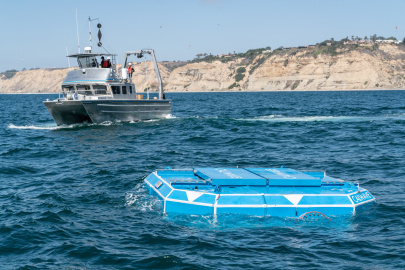Researchers advance triboelectric nanogenerator system prototypes, an emerging and potentially cost-effective technology that could be used to power instruments aboard hurricane and tsunami detection or water quality monitoring systems.
Water Power Technologies Office
March 1, 2023Marine Energy Program
Technology-Specific System Design and Validation
Project Name: Triboelectric Nanogenerator for Harvesting Wave Energy and Powering Marine Sensors
Project Team: Pacific Northwest National Laboratory
Lead Recipient Location: Richland, Washington

Pacific Northwest National Laboratory researchers developed and demonstrated prototypes of triboelectric nanogenerator (TENG) systems. These emerging technologies are aimed at harvesting energy from low frequency, randomly directed waves. TENGs can be used to power instruments aboard hurricane and tsunami detection or water quality monitoring systems, particularly low-power instrumentation such as temperature or pressure sensors. Currently, TENG prototypes can produce a few milliwatts of power.
Researchers integrated cylinder-shaped TENG prototypes with power management circuits, sensors, and communications systems, and demonstrated the feasibility of using TENG technology to power sensing equipment. The team also designed a new disk-shaped TENG device integrated with a mechanical transmission system for efficiently extracting energy from random low-frequency waves. The input of the gearbox takes the back-and-forth (i.e., clockwise and counterclockwise) motion of a pendulum, but spins the disk-shaped TENG device in only one direction, meaning the disk does not need to come to a stop and switch directions.

These TENGs can be easily fabricated using low-cost and versatile materials when compared to conventional electromagnetic generators. In addition, TENGs can float freely and do not have to be moored to the seafloor, which is suitable for powering ocean observation systems and other relevant blue economy applications. While these prototypes currently harness enough energy to power small sensors and transmitters, researchers aim to develop TENGs that produce a few watts of power in the coming years.
Technology-Specific System Design and Validation Projects
-
 New International Report Outlines Opportunities to Integrate Marine Energy with Offshore AquacultureA team led by Pacific Northwest National Laboratory developed a first-of-its-kind report that explored how marine energy can help power offshore aquaculture.
New International Report Outlines Opportunities to Integrate Marine Energy with Offshore AquacultureA team led by Pacific Northwest National Laboratory developed a first-of-its-kind report that explored how marine energy can help power offshore aquaculture. -
 WPTO supported the development of a marine energy standards business plan and operational document updates and became a participating member of the IEC System for Certification to Standards Relating to Equipment for Use in Renewable Energy Applications.
WPTO supported the development of a marine energy standards business plan and operational document updates and became a participating member of the IEC System for Certification to Standards Relating to Equipment for Use in Renewable Energy Applications. -
 During CalWave’s 10-month open-water test off the California coast, its wave energy converter technology remained operational for 99% of the deployment, and the company collected valuable data on device-ecosystem interactions.
During CalWave’s 10-month open-water test off the California coast, its wave energy converter technology remained operational for 99% of the deployment, and the company collected valuable data on device-ecosystem interactions. -
 Researchers at the University of Hawaii took their promising wave energy converter, which could be an especially cost-effective design, from the planning phase into the build and test stage.
Researchers at the University of Hawaii took their promising wave energy converter, which could be an especially cost-effective design, from the planning phase into the build and test stage.
WPTO's Marine Energy e-newsletter shares news and updates on tools, analysis, and emerging technologies to advance marine energy.
The WPTO e-newsletter brings funding opportunities, events, publications, hydropower, and marine energy updates directly to your inbox.


